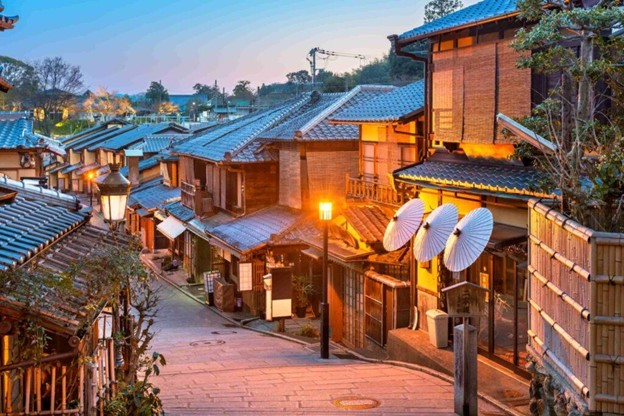Kyoto, a city that breathes history and culture, stands as a captivating testament to Japan’s rich heritage. As we delve into the allure of Kyoto, we are transported into a world where ancient temples whisper tales of bygone eras, and traditional tea houses offer a glimpse into the profound beauty of Japanese traditions…
Introduction
A. Overview of Kyoto’s Allure
Kyoto, nestled in the heart of Japan, beckons travelers with its irresistible charm. The city seamlessly blends the old and the new, offering a unique experience that captures the essence of Japan’s cultural identity.
B. Brief Mention of Ancient Temples and Traditional Tea Houses
At the core of Kyoto’s allure are its ancient temples and traditional tea houses. These cultural landmarks not only symbolize the city’s historical significance but also serve as living monuments to Japan’s past.
Kyoto’s Rich History
A. Historical Significance
Kyoto served as Japan’s imperial capital for over a millennium, shaping the nation’s history and culture. The city’s historical significance is palpable in every cobblestone street and traditional wooden structure.
B. Preservation of Cultural Heritage
Unlike many modern cities, Kyoto takes pride in preserving its cultural heritage. Stringent regulations and a collective commitment ensure that the city remains a living museum of Japan’s storied past.
Ancient Temples in Kyoto
A. Kyoto’s Iconic Temples
From the majestic Kinkaku-ji (Golden Pavilion) to the serene Ryoan-ji, Kyoto boasts a plethora of iconic temples. Each structure tells a story, inviting visitors to explore the spiritual and architectural treasures.
B. Spiritual Significance
These temples aren’t just architectural marvels; they are also sacred spaces. Visitors can immerse themselves in the spiritual ambiance, participating in rituals that have been practiced for centuries.
C. Architectural Marvels
The intricate designs and meticulous craftsmanship of Kyoto’s temples showcase the pinnacle of Japanese architecture. Every detail, from the carefully tended gardens to the ornate roofs, reflects a dedication to aesthetic perfection.
Traditional Tea Houses
A. Tea Culture in Kyoto
Kyoto’s tea culture is a refined art form. The city is home to some of Japan’s most prestigious tea houses, where visitors can partake in the ancient Japanese tea ceremony, a ritual that emphasizes harmony, respect, purity, and tranquility.
B. Unique Experiences in Tea Houses
Tea houses offer more than just a beverage; they provide an immersive cultural experience. Visitors can witness the meticulous preparation of matcha tea and engage in conversations with tea masters who are guardians of this ancient tradition.
C. Blend of Tradition and Modernity
Interestingly, Kyoto’s tea houses seamlessly blend tradition with modernity. While honoring age-old customs, they also embrace contemporary influences, creating a dynamic and evolving cultural landscape.
V. Exploring Kyoto’s Beauty
A. Gardens and Landscapes
Kyoto’s beauty extends beyond its historical sites. The city’s gardens and landscapes, meticulously designed, change with the seasons, offering a visual feast of colors and textures.
B. Cherry Blossoms and Seasonal Attractions
Spring brings a burst of life to Kyoto as cherry blossoms adorn the city. The fleeting beauty of these blossoms attracts visitors from around the world, highlighting the ephemeral nature of Kyoto’s charm.
Perplexity of Kyoto’s Charm
A. Capturing the Essence of Kyoto
Kyoto’s charm lies in its ability to captivate visitors in unexpected ways. The perplexity of its allure ensures that every corner holds a surprise, making exploration a continuous journey of discovery.
B. Intricacies That Surprise and Delight
Whether it’s stumbling upon a hidden temple or experiencing a traditional ceremony, Kyoto’s intricacies surprise and delight, leaving a lasting impression on those fortunate enough to explore its streets.
Burstiness in Kyoto’s Culture
A. Festivals and Events
Kyoto’s cultural calendar is marked by vibrant festivals and events that inject bursts of energy into the city. From Gion Matsuri to Hanami parties, these celebrations showcase the dynamic spirit of Kyoto.
B. Dynamic Cultural Experiences
Beyond the static beauty of its temples and tea houses, Kyoto offers dynamic cultural experiences. Street performances, art exhibitions, and local markets contribute to the burstiness that defines the city’s cultural landscape.
Immersing in Kyoto’s Atmosphere
A. Local Markets and Street Food
To truly experience Kyoto, one must immerse themselves in the local atmosphere. Exploring bustling markets and savoring street food provide an authentic taste of daily life in the city.
B. Interacting with Locals
Kyoto’s warmth extends beyond its architecture and landscapes. Interacting with locals offers a genuine connection to the city’s soul, providing insights into its rich traditions and contemporary lifestyle.
Kyoto’s Impact on Modern Culture
A. Influence on Art and Literature
Kyoto’s timeless beauty has inspired artists and writers for centuries. The city’s influence permeates Japanese art and literature, creating a cultural legacy that transcends time.
B. Kyoto as a Source of Inspiration
Modern creatives continue to draw inspiration from Kyoto. Its aesthetic allure and deep-rooted traditions serve as a wellspring of ideas, influencing everything from fashion to design on a global scale.
Personal Reflections on Kyoto
A. Visitor Testimonials
Countless visitors have been moved by the enchantment of Kyoto. Personal reflections and testimonials highlight the emotional connection that people develop with the city and its cultural treasures.
B. Emotional Connection to the City
Kyoto’s allure is not merely visual; it elicits a profound emotional connection. Visitors often find themselves entranced by a sense of serenity and wonder, creating lasting memories that endure long after they leave.
Planning a Trip to Kyoto
A. Travel Tips and Recommendations
For those eager to experience Kyoto’s magic, careful planning is essential. Travel tips and recommendations guide visitors on navigating the city’s attractions and making the most of their stay.
B. Must-Visit Places
A curated list of must-visit places ensures that travelers don’t miss out on Kyoto’s hidden gems. From iconic landmarks to lesser-known treasures, the city offers a wealth of experiences for every explorer.
Challenges and Opportunities
A. Balancing Tradition and Modernity
Kyoto faces the challenge of balancing tradition with the demands of modernity. The delicate equilibrium ensures that the city evolves while safeguarding its authentic cultural identity.
B. Preserving Kyoto’s Authenticity
Preserving Kyoto’s authenticity requires a collective effort. Conservation initiatives and community involvement play crucial roles in maintaining the city’s unique charm for future generations.
Kyoto’s Global Recognition
A. UNESCO World Heritage Sites
Kyoto boasts multiple UNESCO World Heritage sites, underscoring its global importance. These designations contribute to the city’s international acclaim and draw tourists from around the world.
B. International Acclaim and Tourism
Kyoto’s allure extends beyond Japan’s borders, drawing visitors from diverse cultural backgrounds. The city’s international acclaim has made it a sought-after destination, enriching its cultural tapestry.
Conclusion
A. Recap of Kyoto’s Allure
In conclusion, the allure of Kyoto is a tapestry woven with threads of history, tradition, and contemporary vibrancy. The city’s ability to perplex and burst forth with cultural richness makes it a destination unlike any other.
B. Invitation to Experience Its Magic
To truly understand Kyoto’s charm, one must experience it firsthand. An invitation is extended to all who seek to immerse themselves in a city that breathes life into the past while embracing the future.
FAQs
Is Kyoto suitable for solo travelers?
- Absolutely! Kyoto’s welcoming atmosphere and rich cultural experiences make it an excellent destination for solo travelers.
What is the best time to visit Kyoto?
- Spring, during cherry blossom season, is widely regarded as the best time to visit Kyoto for its breathtaking beauty.
Are there English-speaking guides available in Kyoto?
- Yes, many attractions in Kyoto offer English-speaking guides to enhance visitors’ understanding of the city’s history and culture.
Can I experience a traditional tea ceremony as a tourist?
- Certainly! Many tea houses in Kyoto cater to tourists, offering authentic traditional tea ceremonies.
Are there family-friendly activities in Kyoto?
- Kyoto offers a range of family-friendly activities, including interactive museums, parks, and cultural experiences suitable for all ages.

